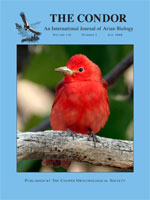Environmental light intensity is known to exert a strong influence on antipredation behavior by influencing prey vulnerability. However, an association between low light levels and increased predation risk is not well established empirically. For species that rely on visual detection of their predators, low light levels can hinder predator detection and thus increase predation risk. We examined the foraging behavior of migrating Semipalmated Sandpipers (Calidris pusilla) on a mudflat in the Bay of Fundy in New Brunswick, Canada as a function of time of day from dawn to dusk. Time of day was used as a surrogate for light intensity, assuming that, on average, light levels would be lower near sunrise and sunset. Sandpipers forage both day and night at low tide, which occurs at different times each day, thus disentangling the effect of light intensity from energy levels. Falcons make surprise attacks on sandpipers by leaving forest cover and flying low over the mudflat, rendering detection difficult against the dark forest background. The propensity for sandpipers to leave a foraging patch by taking flight was higher earlier and later in the day, controlling for temperature and sandpiper density. Pecking success was similar whether a focal sandpiper stayed in the current patch or took flight at the end of a focal observation, suggesting that the choice to leave abruptly was not related directly to food availability. We conclude that increased flightiness likely represents a response by sandpipers to a perception of higher predation risk from falcon attacks at low light levels.
How to translate text using browser tools
1 May 2008
Time of Day and Flightiness in Flocks of Semipalmated Sandpipers
Guy Beauchamp,
Graeme D. Ruxton
ACCESS THE FULL ARTICLE

The Condor
Vol. 110 • No. 2
May 2008
Vol. 110 • No. 2
May 2008
flightiness
light intensity
Peregrine falcons
predation risk
Semipalmated Sandpipers




